Gorgeous Hair Colors for the True Winter Palette

Key Takeaways
- True winter lives for pure coolness and **high contrast**. Embrace icy blues, jet black, crisp white, sapphire, emerald and fuschia and stay away from warm, muted or earthy tones.
- Hair color is most effective when it matches your natural level of contrast. Go for cool blacks, ash browns, icy platinum, rich cool burgundy or silver grey, and avoid golden blondes, warm browns and reds.
- Preserve crispness and vibrancy to differentiate yourself from other winter subtypes. Choose true, cool and bright colors that have no warmth and are stronger than summer colors.
- Try color in varying light to prevent surprises. Check in daylight and indoors, use daylight bulbs at home, and tone regularly with blue or purple to keep brassy.
- Combine with a 1 – partner a pro for pinpoint precision. Request blue or violet-based formulas, introduce strand tests, and schedule regular touch-ups. At home, utilize color-safe care, minimize heat and shield strands.
- Make total symphony by complementing hair, makeup and wardrobe. Create outfit around black, navy, white and jewel tones, opt for cool-toned make up and put together a mood board to inspire your decisions.
💫 Learn Seasonal Analysis
Ready to explore the complete seasonal color analysis system? Discover how to identify your seasonal type and unlock the perfect color palette that enhances your natural beauty.
Learn Seasonal Analysis →True winter hair color are cool, high-contrast shades that complement individuals with deep hair, bright eyes, and cool skin undertones.
Consider blue-black, espresso, ash brown or very cool, iced-out brunettes with no warm reds or golds. To match tone, pick dyes with ash or neutral bases and keep warmth at bay.
For maintenance, employ violet shampoos, sun care, and heat protection. To prepare, we'll discuss shade choices, undertone verifications, swatch strategies and professional consultation advice.
📚 Recent Articles
Understanding the true winter palette
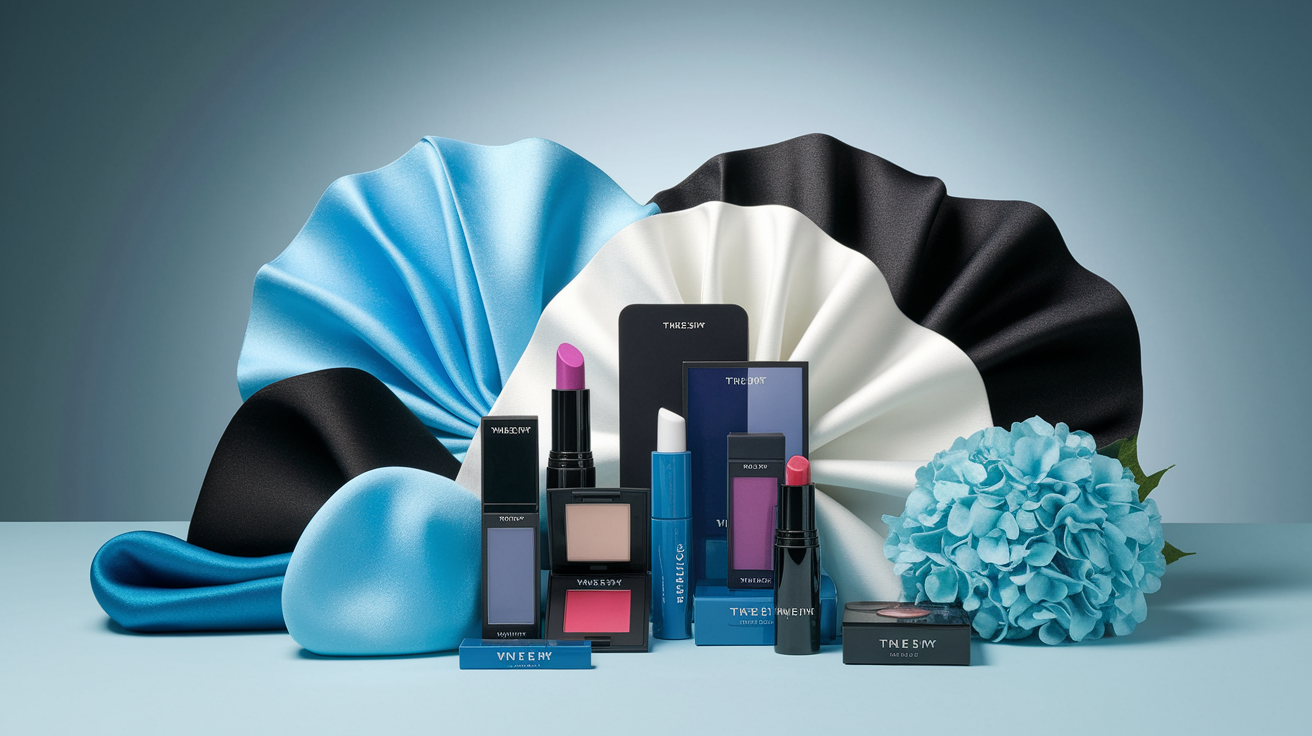
A genuine winter palette revolves around cool, high-contrast, bright colors that appear crisp and frosty. We're talking absolute coolness and clarity in hair, makeup and wardrobe so that the skin's blue or neutral undertone remains clean and bright. Warm, muted, or earthy tones clash with this profile and saps the face, so they are no.
True Winters, for example, look best in icy and **cool winter** colors–not rich warm hues–because those are the direct opposite of their natural coloring.
- Key true winter colors: icy blues, jet black, crisp white, emerald, ruby, sapphire, cobalt, charcoal, fuchsia, and cool red
The core characteristics
True winter hair leans dark and cool. Consider jet black, soft black or medium to dark brown with ashy or neutral undertones. No red light glow, no caramel cast at the tips.
The face says high contrast. Hair is separated from the skin and eyes that can be crystal blue, cool green, gray or deep brown. That clean edge is the signature.
Skin ranges from fair to medium, with cool or neutral undertones. You might get pink, blue or olive hints instead of peach or gold. Silver jewelry seems to look more at home than yellow gold.
There is no warmth showing in hair or skin. If a golden veil dances in the daylight, it typically indicates an alternative season. Silver, white gold and platinum agree most with the cool base.
The contrast is key
High contrast is what defines the **true winter look**. The palette complements that intensity, employing clean pigments that maintain features sharp. Imagine iced soda, not milky tea.
Maintain the contrast when you choose hair color. Blue-black, espresso or cool dark brown work. Steer clear of soft brown, golden brunette or beige blond that melt into the skin.
Textured, knotted colors enhance the natural vibe. A cool red lip, cobalt knit, crisp white shirt and black liner sharpen the whole face. Nail polish in cool reds, berry, plum or ink blue keeps the narrative taut.
Dusty rose or taupe or warm camel makes skin look flat and tired.
Beyond other winters
True Winter is pure coolness, without any trace warmth or extra brightness as Deep (Dark) Winter and Bright Winter do. Its colors are vivid and dramatic, with less mutedness than cool summers and no autumnal warmth.
Compared with Dark Winter, True Winter is cooler and less muted. Compared with Bright Winter, it's a little deeper but remains vividly cool. Wearing cool winter shades from head-to-toe appears pulled together, not try-hard.
| Winter subtype | Undertone | Intensity | Best notes |
|---|---|---|---|
| True Winter | Very cool | High, clear | Icy tones, black/white, jewel tones |
| Dark Winter | Cool leaning | Deep, slightly muted | Inky shades, hints of warmth |
| Bright Winter | Cool leaning | Very bright | Neon-like clarity, crisp contrast |
The best true winter hair color
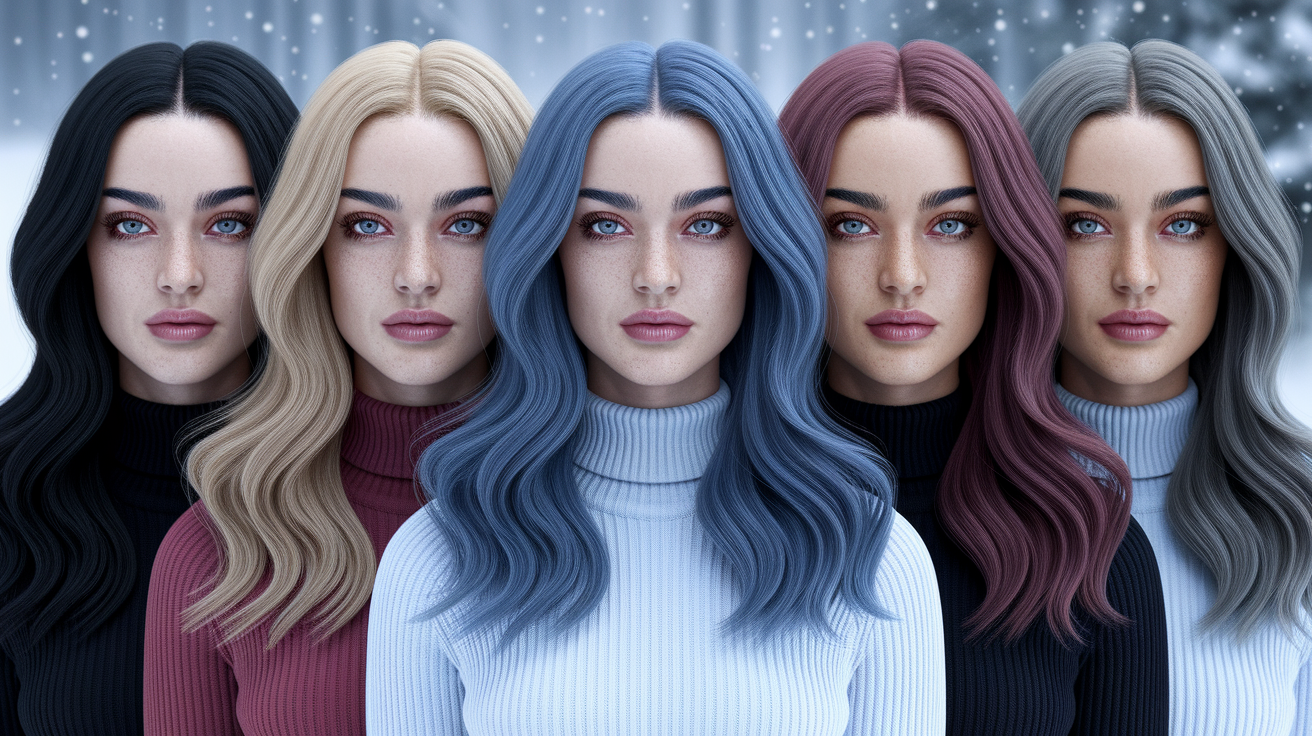
True Winter glows in cool, crisp shades that maintain contrast high and warmth low. Top choices are cool-toned blacks, deep cool browns, icy blondes, rich burgundies, and silver greys. Go for blue, ash, or neutral undertones.
Pass over warm browns, golden blondes, and red-orange hues, they mute clarity. Let your True Winter **color analysis** guide you to select shades that enhance your features and complement the cool palette you wear—consider sapphire, emerald, ruby close to the face for harmony.
1. Deepest black
Jet, coal or raven black tends to be the **True Winter gold standard** as it maximizes the contrast with cool skin and light-to-bright eyes. It frames the face, defines brows, and matches cleanly with winter makeup—blue-red lips, cool fuchsia, ink liner.
Blue-black injects an edge, propelling cooler depth that reads fresh and sleek in front of daylight. Skip soft or warm blacks that bleed into brown because they mute the impact and can drain your skin.
Black in this range is true classic True Winter and often their natural color so many won't require dye at all.
2. Cool dark brown
Espresso, mocha and iced coffee provide depth without the harsh edge of jet. Select labels that read ash, cool or neutral. Avoid red, orange, or gold—no chestnut, mahogany, caramel or bronze, which will wash out cool undertones.
Dark ash brown works well for those who crave structure sans harshness. It looks polished in dim lighting and sparkling in sun. If uncertain, request a strand test and undertone check under white light.
A pro color analysis or swatch test prevents hidden warmth.
3. Icy platinum
Icy platinum, silver-white or blue-white blondes work when you want light hair without warmth. They have to be ash-based because a brassy cast can look unhealthy on cool skin.
Pair with **bold winter makeup**—blue-red lips, graphite liner, cool berry blush—to balance. Maintenance matters: plan regular toning with violet or blue glosses and use purple shampoo to keep yellow at bay.
4. Rich burgundy
Cool burgundy and deep violet-reds add drama, while remaining firmly in the cool lane. They resonate with the jewel tones in the **True Winter palette** and jump next to sapphire or emerald clothes.
Steer clear of burgundy with brown or copper bases — they lean warm. If a full head is too bold, rock 'em as lowlights, a face-frame or a cool ombre over a dark base.
5. Silver grey
Silver/icy grey is chic, ageless and maps to True Winter's cool. Platinum, silver and frosted tones enhance undertones and play nice with monochrome or jewel-hued ensembles.
Keep greys crisp with blue or violet toners and regular purple shampoo. With tender loving care—good products, heat protectant, and less beating up—to preserve shine and color purity.
The illusion of light
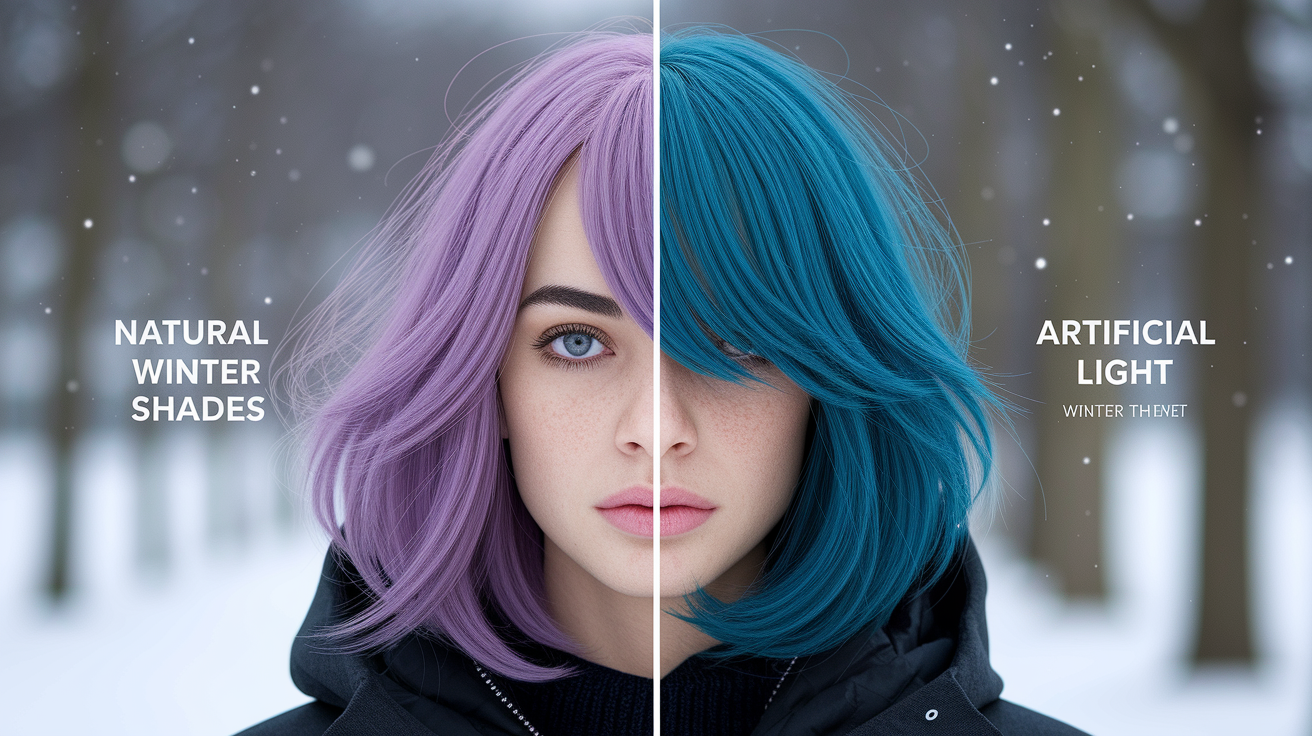
True Winter hair color embodies the essence of true winter colours with its cool, high-contrast, light-illusion qualities. Various bulbs and skies can alter the perception of cool shades. To accurately assess your color choices, verify them in bright daylight and indoor lighting before making a judgment. Cool colors may appear deeper, even ink-like, under warm lamps, so maintain a rapid picasa across settings to confirm your connection with the true winter colour palette.
Seasonal perception
The winter sun is low and blue-leaning, which amplifies the cool shine and sharpness of true winter colours. The crisp noon sky renders ash black glossy, not flat, while blue-black provides a clean edge. Imagine a moonless night: an inky black sky sets bright stars apart, echoing how deep winter hair can illuminate the face. This striking colour combination showcases the essence of true winter individuals.
In the summer, warm glare can drape yellow over cool shades, making ash brown appear soft or muddy. Steel highlights can become brassy in the late afternoon heat. To track shifts in colour palettes, shoot simple photos outdoors at 10:00, 14:00, and 17:00 across seasons.
Adjust your routine with the calendar in mind. During hot months, apply purple or blue shampoo weekly to reduce warmth. In winter, infuse shine with a clear glaze every 6–8 weeks to maintain that crisp, radiant edge, ensuring your true winter wardrobe remains vibrant.
Indoor versus outdoor
Indoor light typically wicks curly hair. Yellow bulbs warm it. Fluorescent strips can wash it out. That same cool espresso can appear luscious al fresco and strangely tan within a café.
Swap bulbs at home with 5000–6500 K daylight LEDs for more accurate reads. Stand by a window at noon for test. Some neat shades—blue-black, charcoal, icy brown—can seem warmer or flatter inside (which can alter the appearance of your skin).
Balance it with **high-contrast styling**: a black crewneck, white shirt, or silver hoop can restore the illusion of light around the face.
Checklist for accurate reads:
- View hair in shade and full daylight.
- Check under warm LEDs, daylight LEDs, and store fluorescents.
- Photograph with and without flash.
- Place black and white near the face; note shifts.
- Compare against cool swatches: sapphire, emerald, ruby.
Cultural context
Notions of "perfect" hair vary by culture and trend. Western style tends to associate True Winter's high contrast with a sleek, edgy vibe—consider classic black and white as the timeless epitome of the illusion of light.
Pop culture keeps this alive: sapphire blue liner, ruby lip, emerald knit, and cool, dark hair make skin look brighter without adding warmth. All the same, style rules. Jewel tones and crisp monochrome add depth and brightness, but dial the mix to your comfort, location and standards.
Achieving your perfect shade
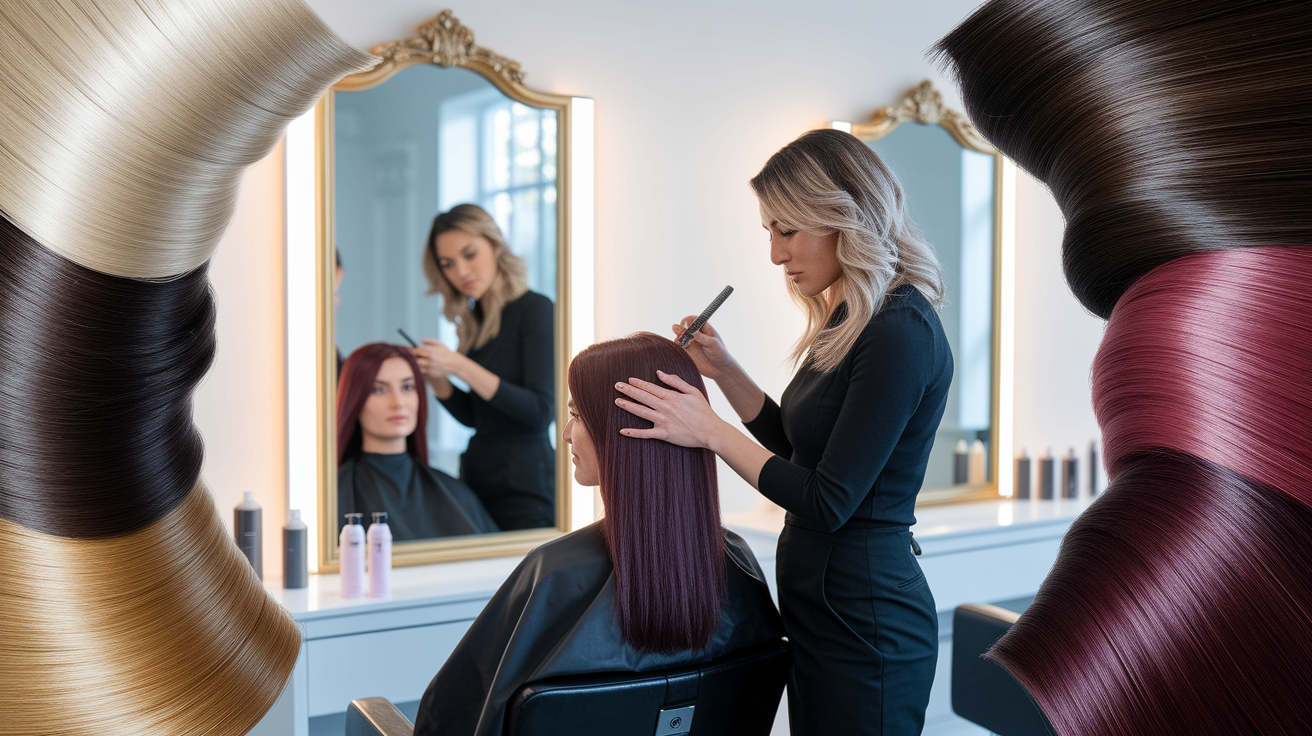
True Winter hair color is magic when the cool, crisp palette intersects with your undertone, contrast, and style. A pro color analysis helps set the right baseline: temperature (cool), value (often medium to deep), and chroma (clear and high). True Winters tend to glow in winter colours—imagine a cool dark ash brown, natural black, blue-black, dark cherry, or a cool platinum or icy blonde—because these reflect the season's sparkling, crispness.
What to expect in a salon: a consult that reviews your **skin tone**, eye clarity, and current hair history; a strand test for lift and tone; a color scheme that honors hair integrity; then exact application and a cool-care aftercare kit. This rinse diminishes brass, maintains contrast equilibrium, and protects from harm. Because even a slight variation in depth or tone can alter your overall contrast levels, seek to be in sync with your face — not the latest trends.
Consider hair type and condition. Fine hair absorbs color quickly whereas coarse hair can sometimes resist dye and therefore requires more time. Curly hair reveals tone on the outside curl, so location is everything. Damaged hair pulls warm–rebuild first to prevent patchy, warm flare.
Trusted pros with True Winter know‑how: 1. Sally Northwood Studio, London — for cool correction. 2. Mare Salon, Los Angeles — precision foils for high contrast. 3. Shiseido Beauty Salon, Tokyo — pro ash control and glossing. 4. Christophe Robin, Paris — subtle lift and toning for cool blondes. 5. Schwarzkopf Professional partners, worldwide — same icy formulas.
Professional techniques
Foiling, balayage, and precision coloring can all work for True Winter when the blend and placement remain cool. Foils provide pristine lift for ash brunettes and icy blondes alike. Balayage works if the light pieces are smoke‑cool, never honey. Precision coloring keeps razor-sharp, high‑contrast lines that compliment this palette's brightness.
Request blue or violet‑based dyes and toners to counteract yellow or orange. We recommend that stylists strand test on a concealed area to preview lift, tone and porosity reaction. Routine appointments every 6–8 weeks maintain lines sharp, roots frosty, and chroma elevated.
At-home color care
Employ color‑safe, sulfate‑free shampoo and conditioner for cool shades. Shoot for low pH to prevent fading. Work in purple or blue toners a time or two a week, to combat brass. Select blue for orange brass on brunettes, purple for yellow on blondes.
Minimize heat. When you do style, heat protectant and lower temps (under 180 °C). UV shields assist outdoors.
Weekly plan: cleanse with cool‑tone shampoo, condition, apply toner mask, rinse cool, finish with leave‑in and oil on ends.
Avoiding warmth
Read the labels. Skip dyes with golden, copper, mahogany or red undertones. Terms such as warm brown, honey, caramel, chestnut or spice cause brass.
Do a patch and strand test so you catch warm shift before a full head. Not certain—cross‑reference shades with online seasonal color resources, such as Dark, True, and Bright Winter.
Cool palettes make everyday styling easy—your hair, clothes and cool‑toned makeup harmonize without overthinking.
Creating total harmony
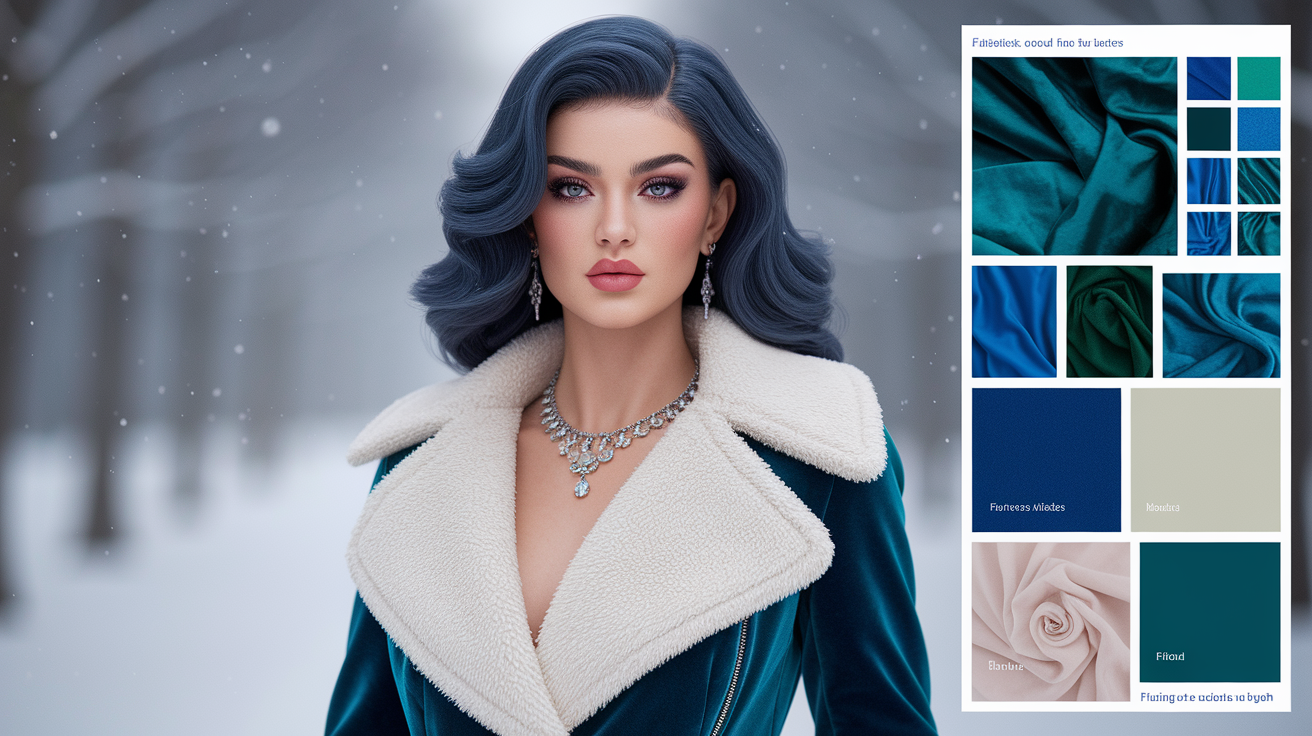
True Winter is at its best when color and texture and pattern are one. Match hair color, makeup and clothes with an obvious, cool palette to craft a look that seems effortless. Unified colors create togetherness, while blended fabrics produce richness without the static.
High contrast, crisp lines, and cool metals assist the eye in reading coherence, which is why this season shines in icy whites, jewel tones, and pure black. Warm or golden tones battle the skin's cool base, so omit them to maintain harmony and self-esteem.
- Collect together pictures of cool-black hair, icy whites, sapphire, emerald and bold reds.
- Add swatches: pure black, navy, cobalt, crisp white, magenta, fuchsia.
- Pin makeup ideas: cool pink blush, silver highlight, blue-gray shadow.
- Include fabrics: satin, silk, leather, fine wool, velvet in jewel tones.
- Note metals: silver, platinum, white gold; avoid yellow-gold.
- Add high contrast pattern (black-white graphic) to test impact.
- Eliminate any warm beige, camel, mustard or peach that dims the vibe.
Complementary makeup
Cool hair deserves cool eyes. Icy blue, sapphire, charcoal and graphite resound with True Winter density. Matte or satin finishes keep edges clean, while a silver shimmer on the inner corner adds light without warmth.
Lips must stand firm. True red, deep berry and fuchsia read vivid and cool complementing black liner and crisp white shirts. They stand their ground next to almost black hair.
Bypass warm bronzers and peach blushes. Use cool pinks, roses and plums – they lift the face without turning orange. Dust a gentle gray contour for shape, not bronze heat.
A tap of metallic silver/icy highlighter on cheekbones and brow bones adds dimension. Keep it elegant, the gloss is to appear like pure light.
Wardrobe color theory
Construct ensembles based on high contrast. Black with stark white. Navy with cobalt. Emerald next to charcoal. The pointed edge reflects your palette's chilling power and pulls everything together immediately.
Use staple colors that never miss: black, navy, pure white, cobalt, sapphire, emerald, magenta, and icy gray. They sync with cool undertones and make hair color pop!
No earth tones, no beige, no camel, no mustard, no dusty pastels. They mute the face and shatter harmony. Go for graphic, high-contrast patterns when you want zap.
| Category | True Winter Essentials |
|---|---|
| Coats | Black wool, navy trench, charcoal wrap |
| Tops | Crisp white shirt, cobalt knit, charcoal turtleneck |
| Bottoms | Black trousers, navy skirt, dark denim |
| Dresses | Sapphire sheath, emerald slip, black column |
| Shoes | Black leather boots, silver flats |
| Accessories | Silver watch, white-gold studs, graphic black-white scarf |
Ideal fabric choices
Sleek, crisp fabrics echo the palette's sharp lines. Think cashmere, silk, leather, and starchy cotton. A slick hand keeps colors clean.
Say no to rustic knits and slub linens and heavy tweeds in warm heather tones. These read fall and smudge the brisk margin.
Look for a subtle sheen: sateen, polished leather, and mercerized knits. Light dances on these forms and intensifies contrast.
Velvet and satin in jewel tones—sapphire, emerald, amethyst—ratchet up the True Winter vibe after dark. They have the color of stained glass and the complement of silver, platinum or white gold.
Common color myths debunked
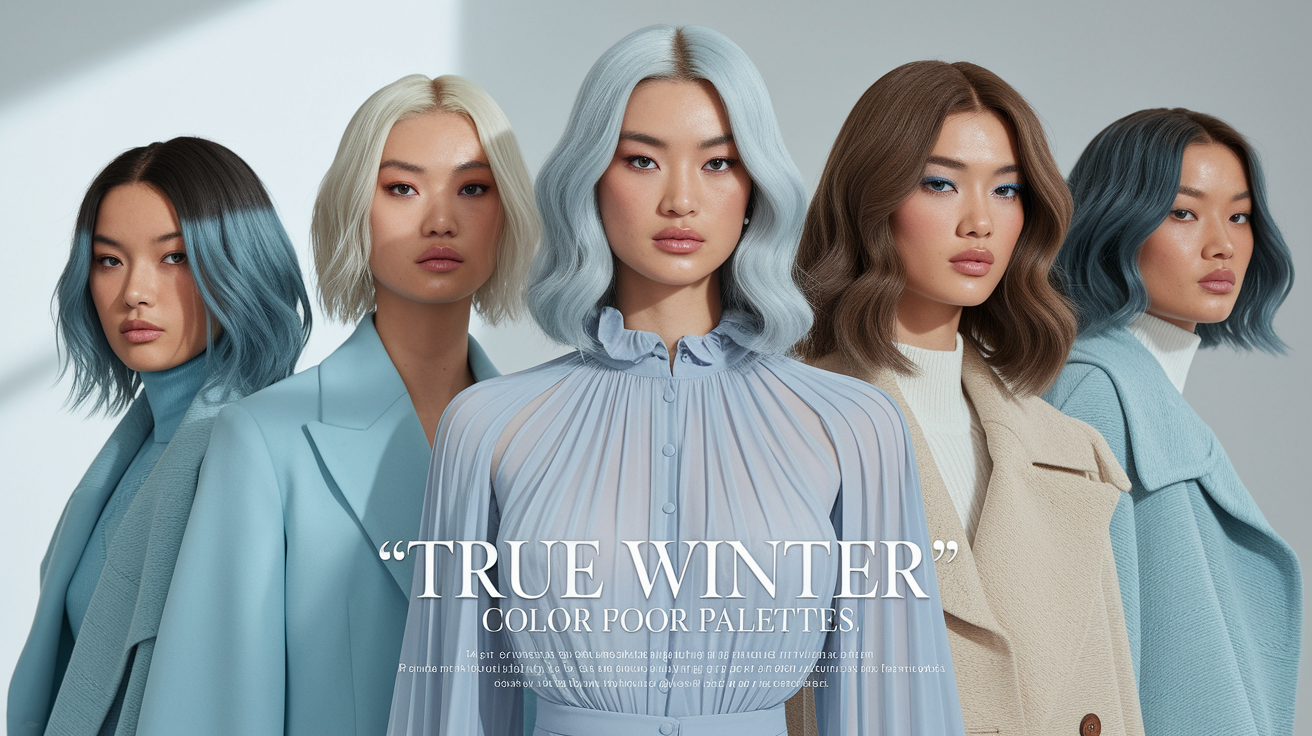
Authentic winter hair color aligns with true winter colours, occupying a cool, high-contrast color space. It requires clean colors that remain transparent, not murky. The right shade enhances your natural contrast and eye brightness, while a wrong shade mutes everything quickly.
Dispel the myth that true winters can wear any dark color; only cool, clear darks are suitable.
Dark does not = right. What works: blue-black, espresso with an ash base, cool dark brown with no red, and inky eggplant. What to skip: warm darks like chestnut, mahogany, or cola brown—they add red or gold that fights with cool skin and can make it look sallow.
If you want depth without flatness, request a cool glaze or a neutral-ash 3–4. Watch your contrast: shift too far darker than your brows and eyes, and you over-crank the look. Little steps maintain equilibrium.
Wear cool-toned makeup as well – a rose-cool blush and a blue-based red lip bring life without warmth. Care still matters in winter: wash as needed to clear oil and product, then seal ends; skipping washes won't 'protect' hair from cold air.
Refute the belief that all brunettes suit warm highlights, emphasizing the need for cool-toned accents.
Warm ribbons like caramel or honey can sap cool complexions, just like caramel or strawberry blonde frequently does. Better choices: ash mocha lights, steel or slate babylights, or cool mushroom brown at the mid-lengths.
Dark hair? Micro-babylights strategically placed at the hairline in a cool level 6–7 lift your entire face without ever going orange. Make the undertone as icy as possible, and if a test strand appears red, tone with blue-violet.
Trims every 6-8 weeks keep ends neat, which helps cool tones reflect light cleanly. Hats and scarves—wool especially—create static and scuff the cuticle, so line them with silk or satin to minimize friction.
Clarify that not all blondes are off-limits—icy and platinum shades work for true winters.
Icy blonde, platinum, and Nordic ash can look crisp on true winters when the foundation remains cool and the lift is clean. Shoot for a neutral-to-blue base toner, not beige or golden.
Balance is key: if you go very light, match brow tone with a cool taupe so facial contrast stays intact. Extensions resist cold air beautifully! Maintain them the same way you would in the warm months – sulfate-free washes, soft detangle, and silicone-free masks.
Leave-in with heat guard, pre blow-dry – winter 'air' is dry and the right products protect all strands, balayage included.
Correct the misconception that true winter hair colors are too harsh, showing how proper color harmony flatters and softens features.
Harsh occurs when undertone battles undertone or when contrast is mismatched. Cool, clear shades – like blue tints or subtle lavenders – reflect white light and lift the eyes and skin, which actually softens lines.
Experiment with a cool shadow root with icy ends for a gentle frame, or blue-black with wispy, ash face-framing pieces. Maintain washing to prevent build-up that dulls color.
Mind small shifts–even a half-level change can skew contrast. If static strikes, trade wool-only beanies for ones silk lined and top with a light anti-static serum.
Conclusion
So to sum it up, true winter hair sings with cool depth, clear shine and crisp contrast. Deep espresso, blue black and cool dark brown nailed it. Ash to warm any day! Shine elevates the entire appearance. A clean cut, neat part and gloss top coat can elevate even a basic color.
Test it with a cool glaze. Experiment with a shadow root. Match brows cool tint Exchange warm blush for cool pink. Watch your skin glow. One client in Berlin opted for blue black and a cool red lip! Glow rose. Skin appeared soft. Eyes shone bright.
Volition, ready to lock your shade. Store a few inspo pics, schedule a patch test, and plot your next move now.
Frequently Asked Questions
What is a True Winter hair color palette?
True Winter individuals look spectacular in cool, high-contrast colors from the true winter colour palette. Consider deep espresso, blue-black, and icy hues, while avoiding warmth and brass. This striking colour combination amplifies natural cool undertones and illuminates the skin, enhancing the overall winter colours.
Which hair colors are best for True Winter?
For true winter individuals, hair colours like blue-black, cool espresso, ash dark brown, and cool black-brown are ideal. When considering highlights, choose icy ash or blue-tinged micro-lights to complement your cool winter skin and maintain a striking colour combination.
Can a True Winter go lighter?
Yeah, but chill. Go with cool ash brown, smoky dark taupe, or icy highlights to complement your true winter colours. Keep a contrast with your brows and eyes, and avoid medium warm blondes that can wash you out and make you look flat.
How do I avoid the "too dark" illusion?
Lighten sparingly around the face with cool micro-lights or shadow root, while incorporating a true winter colour palette for makeup and wardrobe. Good lighting counts, as well, since blue-black can seem severe in warm light, so check colors in natural daylight.
How do I pick a salon formula for True Winter?
Request neutral-to-blue ash bases that complement true winter skin tones. Ask for cool ash or blue-violet toners to enhance your true winter colour palette. A strand test saves you from brass, ensuring your hair colour aligns with your winter type.
How do I create total harmony with my hair color?
Coordinate hair colour with cool makeup and a true winter wardrobe. Opt for blue-based reds, fuchsia, true white, charcoal, and bold cobalt blue. Accent it with silver jewelry. Say no to cream, camel, and warm browns, as fresh cool tones enhance a sophisticated look.
How do I prevent brassiness on cool shades?
Use a blue or purple shampoo once a week to enhance cool winter skin tones. Tone every 4–8 weeks with a cool ash gloss for a striking colour combination. Steer clear of heat damage and chlorine while opting for sulfate-free care and UV protection.